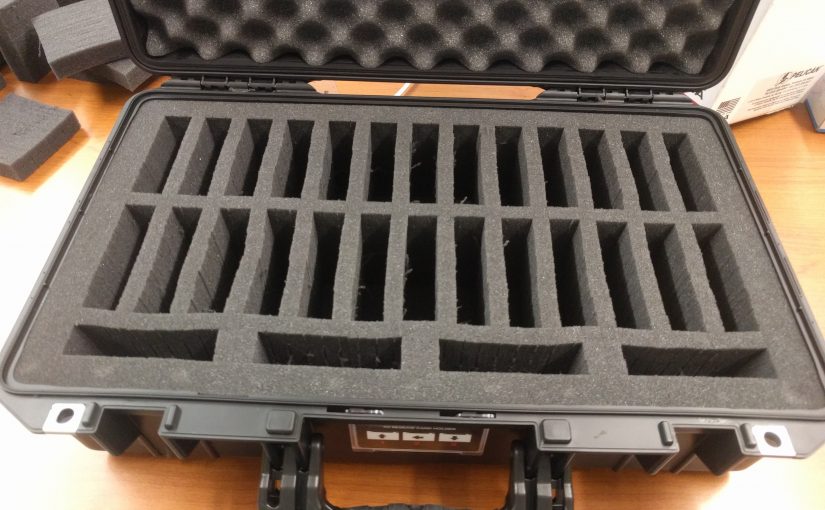I was looking for a watertight case to store a bunch of 3.5″ hard drives. The idea was to protect the off-line backups from water damge in case sprinklers get activated in the building. It was decided that water or dust damage was a more likely threat than fire, so the solution did not have to be fire safe.
I chose the Pelican 1525 Air case because, from the specs, it looked like it had a good fit for the drawer where we have been storing the hard drives already and because it seemed that it would accept a hard drive vertically, thus maximising use of the case volume.
The foam can be cut to fit 30 hard drives – two rows of thirteen plus one row of four. The resulting slots are a perfect fit for a hard drive – removing 2×8 square sections creates slots that are just right to accept the hard drive vertically. Enough of the hard drive protrudes above the slot, making grabbing them easy.

One caveat is that the lid is difficult to close because it is filled with foam. Thirty drives have quite a bit of surface area to make compressing the foam in the lid very hard. Our solution was to get rid of the foam from the lid, because we don’t need that much physical protection. The case will be stored in a drawer and there is no danger associated with removing the padding from the lid. If you need to leave padding in the lid, you may have to modify the foam in the lid and/or in the bottom, to either make it a bit thinner or to create notches where the hard drives come into contact with the foam.

We store three hard drives per year, so thirty hard drives allow for ten years of offline backups to be stuffed into one Pelican case.

Makes me a tad nervous seeing those bare drives’ contacts touching the foam without any ESD-protection around them. ^_^’ If you didn’t know, there are metallized ESD-protection bags sold online just for the purpose. Maybe check ’em out? 🙂
I’m considering storing my personal hard drives in a Peli(can) (European version is called Peli) case. Thanks for sharing the photos of your setup!
Thanks for sharing. I have been struggling with hard drive storage as well and almost did the same thing as you using the pluck foam, but then I finally dug up a Chinese made custom case which is nearly half the price. The foam is a little more stiff than the Pelican variety and so for long term storage it seems like a good fit.
https://www.amazon.com/ORICO-External-Multi-Protection-Carrying-Briefcase/dp/B0714BK6RX/ref=sr_1_14?keywords=orico+hard+drive+hard+case&qid=1563627472&s=gateway&sr=8-14
Thanks, Christian, that product looks pretty good. I especially like the denser foam. It is also cheaper, but stores 20 hard drives compared to 30 in the Pelican 1525 case.
Looks nice ‘n cozy for the hard drives. 🙂 As Mr. Anonymous mentioned, I would also employ the metallized plastic bags for the hard drives, or an anti-static foam insert.
So if these are your backup drives, how do you store the originals (or additional backups)?
I noticed that there isn’t any redundancy from a hardware failure point of view in this case (no pun intended) because there seems to be only one drive per season stored.
The original data lives on a 16-disk RAID6 array of SSDs, with two hot spares.
We make a full backup each night, and keep 6 daily, 3 weekly, and 3 monthly copies online (i.e. inside the backup server). Then, every 3 months we pull one drive out and store it offline in that Pelican case. One daily and one weekly backups are also automatically synched to an off-site server. This scheme has been working for us really well for the last 20 years, if not more. Naturally, everyone has different backup needs, and our scheme may not fit all scenarios, but I’m happy to share it.
As for antistatic bags, theoretically, you are right, but, in practice, I have never seen any computer component fail because of static electricity in my 30+ years of experience.